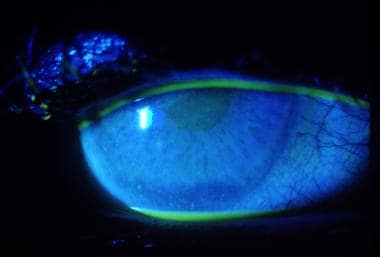Background
Ultraviolet (UV) light is the most common cause of radiation injury to the eye. The cornea absorbs most UV radiation. UV radiation damage to the corneal epithelium is cumulative, similar to the effects with dermal epithelium (sunburn). Ozone in the atmosphere effectively filters most of the harmful UV radiation of wavelengths shorter than 290 nm; natural UV sources, such as the sun, rarely cause injury after short exposures. However, unprotected exposures to the sun or solar eclipses or exposure to the sun on highly reflective snow fields at high elevation can lead to direct corneal epithelial injury. The latter clinical scenario is known as snow blindness.
Artificial sources of UV radiation also cause corneal damage. Injury from a welder's arc commonly is known as flash burn, welder's flash, or arc eye. Other sources of UV radiation injury include sun tanning beds, carbon arcs, photographic flood lamps, lightning, electric sparks, and halogen desk lamps. Several outbreaks of ultraviolet keratitis have been observed in the United States after installation of improper lighting in school gymnasiums, resulting in high levels of UV radiation. [1]
Prolonged exposures to UV radiation can lead to chronic solar toxicity, which is associated with several ocular surface disorders (eg, pinguecula, pterygium, climatic droplet keratopathy, squamous metaplasia, carcinoma). The only ocular cancer associated with UV radiation is epidermoid carcinoma of the bulbar conjunctiva, which occurs with increased frequency in the tropics and subtropics and has been experimentally replicated in animal models using UV radiation. Rarely, retinal absorption of visible to near-infrared (400-1400 nm) radiation from welding arcs can lead to permanent, sight-threatening injury. [2]
Pathophysiology
The cornea transmits most of the visible light spectrum, including the UV spectrum, with absorption by the corneal epithelium. [3] The cornea absorbs 10%-20% of UV-A and close to 100% of UV-C. [4] UV rays irritate the superficial corneal epithelium, causing inhibition of mitosis, production of nuclear fragmentation, and loosening of the epithelial layer. Under experimental conditions in animals, phototoxic effects have been demonstrated at all levels of the cornea, including the stroma and endothelium. [5]
An inflammatory response occurs, which includes edema and congestion of the conjunctiva and a stippling of the corneal epithelium known as superficial punctate keratitis (SPK). SPK is a nonspecific corneal condition associated with multiple ocular disorders. It is characterized by small pinpoint defects in the superficial corneal epithelium, which stain with fluorescein. If SPK is severe, it may be followed by total epithelial desquamation, with conjunctival chemosis, lacrimation, and blepharospasm. Reepithelialization usually occurs within 36-72 hours, and long-term sequelae are rare. This SPK contrasts with the more severe effects frequently encountered with corneal damage caused by alkaline or strongly acidic chemicals.
In general, ocular pain, photophobia, redness, and decreased visual acuity occur 6-12 hours after the injury. This lag time involves an unexplained pattern of corneal sensory loss and return and is thought to indicate a probable photochemical injury rather than a thermal injury to the cornea.
Epidemiology
Frequency
United States
UV keratitis and UV keratoconjunctivitis are the only radiant exposure conditions of the cornea that occur with any significant frequency in the United States. [6]
Mortality/Morbidity
No reported mortality occurs. Morbidity results from UV radiation damage to the superficial corneal epithelium, which usually heals spontaneously within 48-72 hours of the exposure. Long-term sequelae, which may result from superinfection, are rare.
Sex
No difference in incidence is observed between males and females.
Prognosis
The prognosis is excellent for full recovery within 24-76 hours.
Patient Education
Educate patients about proper eye precautions, such as the use of UV-filtering lenses or limiting exposure to the sun. The condition is preventable with the appropriate precautions.
For excellent patient education resources, visit eMedicineHealth's Eye and Vision Center. Also, see eMedicineHealth's patient education article Corneal Flash Burns.
-
Diffuse uptake of fluorescein stain as seen in ultraviolet keratitis.



